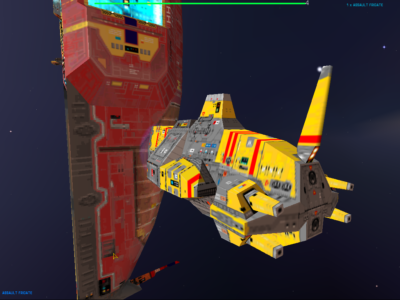Today marks the start of an occasional series where I look back on particular gaming experiences that have made a strong impression on me, over the years.
Mostly I’ll write about positive memories, but they don’t have to be exclusively so. They could be moments of appreciating real excellence in game design, or frustration at terrible design. They may be triumphs against legions of foes, or rage quitting against super-tough bosses. I could write about taking a walk in Skyrim just to quietly enjoy the view. Or a time when everything went hilariously, disastrously wrong in a battle in UFO Enemy Unknown.
We’ll start with Homeworld. Relic’s seminal realtime strategy game was first brought to my attention when I came across a preview in PC Zone. I recall screenshots showed chunky, primary-coloured starships, all rendered in 3D. The article promised full three-dimensional control of entire fleets. I thought to myself, this was all rather impressive. A whole new level for the genre, a quantum leap from Starcraft and Red Alert.
My first taste of actually playing Homeworld occurred when I tried the demo, sometime around the summer of ’99. It consisted of the first few tutorial levels. So you’re shown the mothership, you’re told to build a few little fighter craft, you send them to blow up some drone targets and then some enemy fighters.
It made a good impression from the start; the movement of ships was fluid and convincing, the controls slick and intuitive. Then I was given control of a Frigate, a mid-sized gunship. I told it to go deal with those fighters still buzzing around. It slowly picked up speed and yawed to one side, and then with a WHIRRRR its four turrets all turned to track the enemies.

Somehow, that WHIRRR was the moment I was totally sold on that game. Just one modest frigate against a few buzzing interceptors, yet that minor battle is still etched into my memory all these years on. It was the attention to detail, the fact that not only was this game going to give me lots of warships to command, but the big ones had independent weapon systems. The feature gave the ship a sense of mass – the turrets existed because it was too ponderous to spin on the spot like a fighter. Also there was an mechanical urgency to the sound, a signifies that the ship was armed ready for battle, cannons prepare to spit shells into the void.
It was part of made Homeworld feel like commanding one side in a battle from one of my favourite space operas. The frigates and destroyers handled just like a Star Destroyer from Star Wars, or the warships in Babylon 5.
I purchased the game later that year. I learned that bigger ships provided even more WHIRRR, especially the monstrous heavy cruisers with oversized laser turrets that atomize a frigate in seconds. To this day it remains one of my all time favourite RTS, and I’ll most likely write about it here again.



 Posts
Posts